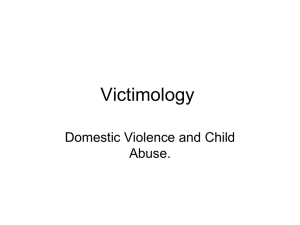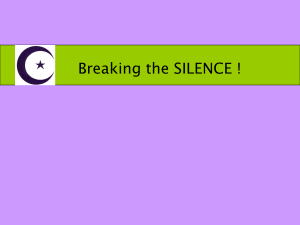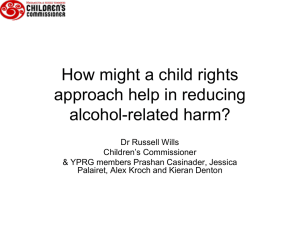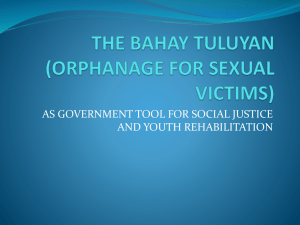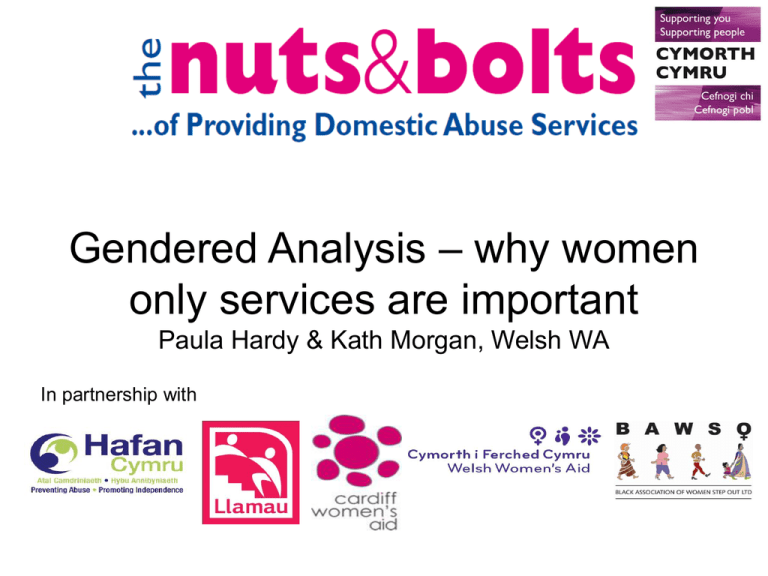
Gendered Analysis – why women
only services are important
Paula Hardy & Kath Morgan, Welsh WA
In partnership with
Gendered Analysis Why Women Only Services
Are Important
What is Gendered Analysis?
At a minimum, we are referring to an analysis which recognises:
• that violence is endemic and functional within human interactions and
structures. There are many expressions of violence which are
considered normal, legitimate and even honourable;
• that violent practices and behaviours – from interpersonal to
international levels, in families, communities and in wars – are
gendered;
• that men are statistically and overwhelmingly the main perpetrators of
violence (especially severe and injurious violence) against other men
and women;
• but that by no means all men are violent or abusive;
• that some women use violence and abuse behaviours;
• that the meaning, use and consequences of violence by men and by
women is not equivalent and cannot be understood in isolation, but as
an expression (and sometimes subversion) of wider social factors;
• that the key to understanding the differences between men’s and
women’s violence lies in an examination of the contexts within which
violence is perpetrated
What is Gendered Analysis?
In their rationale for switching to a gender-based perspective for
domestic abuse, the Scottish Government provided the following
useful definition of gendered analysis:
A gendered analysis argues that the social phenomenon
of domestic abuse can only be properly understood by
considering its history, context, meanings, impact and
consequences through the lens of gender. Unless we
take seriously the ways in which sex difference has been
used to systematise subordination, we cannot get to
grips with the normalise possibility of violence and abuse
in gender relations.
Why a Gendered Analysis?
• WAG accepts that the overwhelming majority of
domestic abuse is perpetrated by men against women. It
is therefore a gender issue, and requires a gendered
analysis. However, this is entirely absent from current
policy
• The world in which we live and form relationships in,
within which violence sometimes takes place, is not
gender-neutral.
• Our relationships to each other, and the violence that
sometimes occurs within intimate relationships, do not
take place in a vacuum, but within a wider society which
is still very much based on gendered (and racial, class,
age etc.) power relations.
Background
• Wales’s first integrated strategy to tackle all forms of
violence against women (VAW) launched in 2010
• Carl Sargeant AM stated that the Strategy will
incorporate responses from the public consultation on
a Strategic Action Plan to Update the Domestic Abuse
Strategy and to Tackle Violence Against Women
• The Minister identified three key messages to arise
from the consultation, one of which was: ‘the need to
provide more services for male victims of domestic
abuse’
Background
• Several WA groups have been under
pressure to open their doors to men, or to
provide mixed-service services
• Men can be victims of domestic abuse, and
proportional services are required
• Available research and experiences of service
providers - services required by men are
different, including important differences in
scale, incidence and effects
What are Sex & Gender?
• SEX refers to the biological characteristics
(genetic and anatomical) which define
humans as female or male.
• These characteristics are not mutually
exclusive (some individuals possess both)
and can be modified, but they function to
differentiate humankind as female and male
World Health Organisation
What
is Gender?
What
are Sex
& Gender?
• GENDER refers to the array of socially constructed
roles, traits, attitudes, behaviours, values,
responsibilities, relative power, status and influence
ascribed to male and female humans on a differential
basis.
• Gender identity (masculinity/femininity) is not biological,
but learned.
• It is changeable over time, and varies widely within and
across cultures.
• Gender refers not simply to women and/or men, but to
the relationships between and among them.
• Gender identities condition the way human beings are
perceived, and how they are expected to think and act.
World Health Organisation
Gender Based Violence
Gender-Based
“Any form of violence used to
establish, enforce or perpetrate
gender inequalities and keep in
place gendered orders. In other
words gender based violence is a
policing mechanism.”
James Lang 2002
Gender Base Abuse
GBA does not only mean abuse perpetrated by
men against women
Examples
• FGM is largely committed by women who are
policing other women to keep them pure and in
their position in society as a woman
• Homophobic abuse is about punishing men or
women who do not conform to their gender role
• Male rape - about a man making another man
subordinate to him by effeminising him
Gender Base Abuse
All Violence Against Women is gender
based abuse in that it punishes and
controls a woman’s social role
International Consensus
‘Violence against women is a manifestation of
historically unequal power relations between
men and women, which have led to domination
over and discrimination against women by men,
and the prevention of the full advancement of
women; and that violence against women is one
of the crucial social mechanisms by which
women are forced into a subordinate position
compared with men’
UN General Assembly, 1993
DA is Gender Base Abuse
Welsh Women's Aid maintains that
domestic abuse is the result of the
continued inequality between men and
women in society. Therefore, society
tends to condone aggressive acts from
men in the long term and boys are
raised to assume control over women
in all areas of work, home and
relationships.
DA is Gender Base Abuse
To say that domestic abuse is gender-based
is simply to recognise that the socially
attributed norms, roles and expectations of
masculinity and femininity which affect
intimate relationships and family structures
are integral to the use and experience of
violence and abuse, whether perpetrated
by men or women. (Lesley Orr, 2007)
Exercise
What are the socially attributed norms, roles
and expectations of masculinity and
femininity?
How might these be used by a perpetrator
against a victim?
DA is Gender Base Abuse
• Domestic abuse perpetrated by a man against a
woman is framed by society’s expectations of how
a woman should behave and what her role is in
relation to men, and in particular, her male partner.
• It involves notions of male privilege and
entitlement e.g. sexual availability / ownership,
domestic chores, mother-child relationship,
gender-related insults and emotional abuse (slag,
bitch, fat, bad mother etc.)
• Domestic abuse perpetrated by a woman against a
man would involve attacks on his masculinity
Gendered Analysis
Questions such as:
• the difference in experiences of DA
• impacts of DA on women and men
• roles and responsibilities
• who does what
• who has what
Will lead to an understanding of ‘who needs what’
Gendered Analysis in Action
• Equality means everyone having equal levels of
access and opportunities regardless of their
individual differences, which involves treating
people differently
• Equality Duty: Equality has mistakenly been
taken to mean similar treatment and gender
neutrality – but there are substantive inequalities
and differences between women and men –
different services are needed to provide the
same outcome for each gender
• Different needs must be met by different
services
Why Women Only Services?
• Services which have been created with
women’s needs in mind are not a perfect ‘fit’ for
male victims
• Assumptions that single-sex domestic abuse
services can become mixed-sex, fail to take
into account men’s and women’s specific, and
often different, needs
• Gender-neutral approaches are not helpful
(and can be dangerous) for either male
or female victims
Different Level of Need
2009/10 BCS & Police Recorded Crime Figs.
Women were victims in nearly three-quarters (73%)
of reported domestic violence incidents
Men were identified as perpetrators in 79%
54% of female homicide victims aged 16 or over
were killed by a current or former partner – compared
with 5% of male victims being killed by a current or
former partner
CPS figs.
94% of defendants were men in 2009/10
85% of victims were women in 2009/10
Different Nature of Abuse
Research by Prof Marianne Hester
‘Who Does What to Whom’ (2009)
Women experience a greater amount, and more severe
abuse from male partners
Physical and emotional impacts on female victims were
significantly greater than on male victims
Women’s use of violence has been found in a number of
studies to be defensive or retaliatory rather than initiating
Looking at 96 samples of equal numbers of male perp, female
perp, and dual perp cases over a period of 6 years to establish
‘who does what to whom’
Different Nature of Abuse
Men significantly more likely to be repeat perpetrators (83% highest number of incidents was 52), whereas women were more
likely to be one-off (62%, and highest number of repeat incidents
was 8)
Men significantly more likely to use physical violence, threats and
harassment
Cases involving men as sole perp’s were those most likely to result
in intense fear and control of their partners
Only one of the women recorded as the sole perpetrator was
similarly described by the police as creating a context of fear and
control of the male victim. In this instance the woman was very ill.
Police more likely to question whether or not they had correctly
identified the perpetrator in instances involving a woman
When looking at cases where at different points both the woman
and man had been recorded as a perpetrator: 45% female
perpetrators had only one incident recorded compared to 13% of
men
Different Level of Need
WDAH figs.
In 2009/10, 97% of callers to the genderneutral Wales Domestic Abuse Helpline who
were experiencing DA were from women and
3% were from men
MARAC Figures:
Between June 2009 to June 2010, only
3.25% of referrals across England and Wales
were for male victims
Different Services Required
Gender neutral Approach does not support
WAG’s commitment to citizen centred services
UN Committee’s recommendations to UK Government in
report to CEDAW:
‘The application of a “neutral”
policy can have the outcome of
disadvantaging women’
Different Services Required
Men’s Advice Line Signposts in 2009
28% to legal advice centre
16% to Police and/or Community Safety Unit
9% to housing advice agency for housing matters
other than emergency housing (refuge)
8% for individual counselling
3% (47 callers) for refuge
(of the WDAH callers – 20% of callers, a total of 5,203
women required refuge)
Need to Assess Men
The Dyn Project
Of a sample of 171 males, Dyn found that 46% were
heterosexual men with a known history of abusive or violent
incidents (33% were heterosexual men with no known history
of abuse)
Men’s Advice Line
79 callers initially presented as male victims of female
perpetrators – workers identified 36 as perpetrators by the end
of the call.
11.4% of those who presented as victims accepted by end of
the call that it was their own behaviour that was abusive
Historically, Men’s Advice Line have found that one third of
men who present as victims are identified as perpetrators
Need to Assess Men
This one third take up significant time and effort
from workers – making it more difficult for the other
two thirds to access the service
Very different to experiences of service providers
who work with women, where vast bulk of time spent
delivering services
Failing to screen may result in collusion with
perpetrator
Given high number of men presenting as victims
who are perpetrators – mixed sex services may put
women and children at risk
Single Sex Services
Over 90% of women support a woman’s right to access
women-only services
Male victims have also been reported to feel ‘uncomfortable’
in a service geared towards women and children
Services for men should be tailored towards men in their own
right
Single-sex services should work within a multi-agency
framework:
‘a heterosexual men’s project will always need to be linked to a
service for women… because the boundary between victim
and perpetrator is often blurred for these men, a close
coordination between these services is vital’ (The Dyn Project)
Do Men Require Refuge?
Assumption from non-specialists that male victims
require same service as women
Current need for male refuge spaces substantially
less than that for women
‘the need for bed spaces for men is not of
the same order or magnitude as for women’
(Home Office Select Affairs Committee)
Do Men Require Refuge?
‘The issue of men’s refuges has been somewhat
misrepresented by some for political reasons that
have more to do with misogyny than concern for
genuine individuals’.
(Men’s Advice Line)
Two out of the UK’s seven recognised refuges for
male victims has closed due to lack of demand.
Why Wouldn’t Men Require Refuge?
Most male victims do not express the same levels of
fear as women, and in particular are significantly less
likely to feel fearful in their own home
Women experience a greater amount of abuse from
their male partners than vice versa; man are less
seriously injured
Men report women’s violence as ‘inconsequential’ and
not affecting their wellbeing or safety; women report
greater emotional, psychological and physical impact
Men’s violence creates a context of fear and control,
which is less often the case for women’s
Why Wouldn’t Men Require Refuge?
Most men will remain in their own homes due to
commitments relating to gendered roles, such as
being more likely to be in f/t employment, more likely
to be homeowners and more likely to be financially
independent than women
Women still make up the vast majority of primary
caregivers. Children are at significant risk of being
abused in domestic abuse scenarios, or of witnessing
abuse which has significant damaging effects. Over
half of all occupants of WA refuges are children
Refuge Spaces for Men
Important exception is male victims of HBV
• Gemini found that 4 of their 14 male victims who
they supported in refuge were fleeing HBV
• The Home Office Select Affairs Committee also
reported that male victims of forced marriage may
need emergency housing
• This client group represents a more specific set of
service user needs e.g. younger, more isolated,
fleeing more than one perpetrator
• Strengthens argument for specialist service
provision
Sexuality and Male Victims
GBT male victims have different needs & experiences to heterosexual men
• For genuine male victims, twice as many gay men
as heterosexual men were identified as ‘high’ or
‘very high’ risk
• 27% of gay male referrals were repeat referrals
compared with 3% of heterosexual men
• Sexual violence is often central to GBT DA (but is
not common for heterosexual male victims)
• The threat to ‘out’ remains a central weapon
• Fears of homophobia from services and police and
lack of specialist services prevents victims
accessing
Sexuality and Male Victims
Screening is also essential for GBT:
‘because the dynamics of the relationship may not make it
possible to easily identify the role of each partner or there may
be a history of counter-allegations’
The need for specialist services is even more acute in the cases
of GBT victims; workers must understand the:
‘unique aspects of domestic abuse as they affect the GBT
communities’
The Dyn Project
Needs of Male Victims
•
•
•
•
•
•
•
•
Target hardening and crime prevention
Housing referrals
Alternative accommodation rather then refuge
Outreach community services – including
approaches which holistically address issues of
masculinity
Informal but direct, non-social-work-driven
contact – less likely to engage in group self-help
Helpline services
Referrals to perpetrator programmes
Appropriate risk assessment procedures
Importance of Women-Only Services
• Level of need and type of needs are different
• Male centred services are best for men
• Women centred services are best for women
and children
• Women and children are disproptionately
affected by DA
• Due to high volume of male perpetrators
presenting as victims – serious safety issues
involved for women and children in services
being gender-neutral
Conclusion
•
•
•
•
Safety of victims should be paramount
Women and men require different services
Both require specialist services
Separate specific services are more able to
provide specialist services
• Services for men are required, they should be
proportionate and respond to need - and
should not detract from women’s services
Paula Hardy
Chief Executive
paulahardy@welshwomensaid.org.uk
Kath Morgan
Accreditation Project Coordinator
kathmorgan@welshwomensaid.org.uk
www.welshwomensaid.org.uk
t: 02920 390 874







